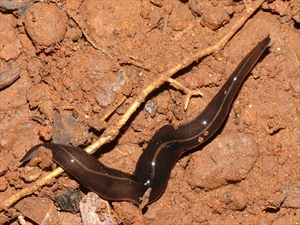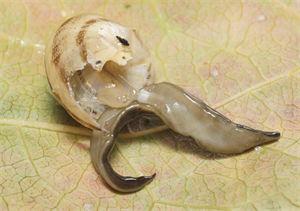New Guinea flatworm
Pacific Pests, Pathogens, Weeds & Pesticides - Online edition
Pacific Pests, Pathogens, Weeds & Pesticides
New Guinea flatworm (385)
Platydemus manokwari
Southeast and East Asia (Indonesia, Japan, Philippines, Republic of Maldives, Singapore, Thailand), North America (Hawaii and Florida), Europe (restricted – hot-house in France), the Caribbean (Puerto Rico), Oceania. It is recorded from Australia (Northern Territory and Queensland), Federated States of Micronesia (Pohnpei), Fiji, French Polynesia, Guam, New Caledonia, Northern Mariana Islands, Palau, Papua New Guinea, Samoa, Solomon Islands, Tonga, Vanuatu, and Wallis & Futuna. The flatworm is known from lowlands to more than 3500 m (Papua New Guinea).
Snails, slugs, and other species of flatworms, and invertebrate animals such as earthworms and cockroaches.
A voracious predator of introduced and endemic snails, plus other terrestrial molluscs as well as earthworms. It is found in a variety of habitats, although it favours forests, plantations and orchards, especially disturbed areas, those that are moist, but not wet. It is commonly found in leaf litter, under rocks, timber, and within the leaves and cavities of banana, palms, taro and other root crops.
The flatworm reproduces sexually, although if divided into separate pieces each regenerate into complete flatworms within 2 weeks. Several eggs are laid together in a cocoon, 2-5 mm diameter, surrounded by mucus. Three-weeks later the flatworms are capable of egg laying.
Very flat, (hence the name), 40-60 mm long and 4-7 mm wide, broadest in the middle and tapering to both ends, black olive on the back with a clear central stripe, and a pale white belly (Photos 1&2). The head is elongated, with two prominent black eyes and the mouth is in the middle of the belly (Photo 2). It lives mostly on the ground, following the mucus of snails using chemical cues, even climbing trees to reach them.
In addition to their natural spread – they are highly mobile - flatworms can easily spread with infested plants, plant parts and soil, especially in the domestic and international horticultural trade.
This is the only flatworm in 100 of the World's Worst Invasive Alien Species in the IUCN Invasive Species Specialist Group’s Global Invasive Species Database (2018). There is grave concern for the future of unique endemic land snails of Pacific islands where the flatworm has been introduced (often to control the giant African snail (see Fact Sheet No. 50). The presence of the flatworm in Florida is also of concern as it could potentially spread throughout the US mainland and to the rest of the Americas. Equally concerning is finding the flatworm in a hot-house in Caen, France.
Positive economic impacts have been recorded from several countries (e.g., Guam, the Philippines, Republic of Maldives) where the flatworm has been introduced to control the giant African snail. Savings due to reduced plant damage and snail baits have been identified.
The flatworm is a host of the rat lung worm, Angiostrongylasis cantonensis, passing the nematode to human beings on cabbages eaten raw.
Look for the flatworm at night in natural or artificial sites – under tiles, sand-filled plastic bags, wooden boards or among snails placed in 2 mm nylon mesh bags used as baits. There are other Platydemus species, so examination by a specialist is advisable.
QUARANTINE
Every effort should be made to protect countries not yet infested, those few remaining in the Pacific island region and those elsewhere. Introductions of the flatworm should not be allowed to control outbreaks of the giant African snail (see Fact Sheet No. 50).
Treat and inspect plants to prevent spread in the international, horticulture trade as follows:
- Check all exported and imported plants carefully.
- Insist that plant introductions from overseas are grown in soil-less compost or are bare-rooted cuttings.
- Where soil-less medium is not practical, ensure that the part of the plant contained by soil has been treated BY placing it in a plastic bag before immersion in hot water at 43°C for 5 minutes. A method used in New Zealand.
CULTURAL CONTROL
- Make artificial sites or baits as suggested under Detection & Inspection above, and destroy any flatworms collected.
- Kill the flatworms by pouring boiling water on them.
AUTHOR Graham Jackson
Information from CABI (2018) Platydemus manokwari (New Guinea flatworm). Invasive Species Compendium. (https://www.cabi.org/isc/datasheet/42340#0609B122-9841-41F6-8164-F693839696BE); and (including Photos 1&2) Platydemus manokwari. Wikipedia. (https://en.wikipedia.org/wiki/Platydemus_manokwari); and from Peer J (2015) Discovery in the US of the New Guinea flatworm, one of the worst known invasive species. ScienceDaily. (www.sciencedaily.com/releases/2015/06/150623095501.htm).
Produced with support from the Australian Centre for International Agricultural Research under project HORT/2016/18: Responding to emerging pest and disease threats to horticulture in the Pacific islands, implemented by the University of Queensland and the Pacific Community.





